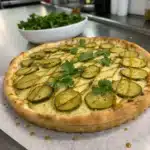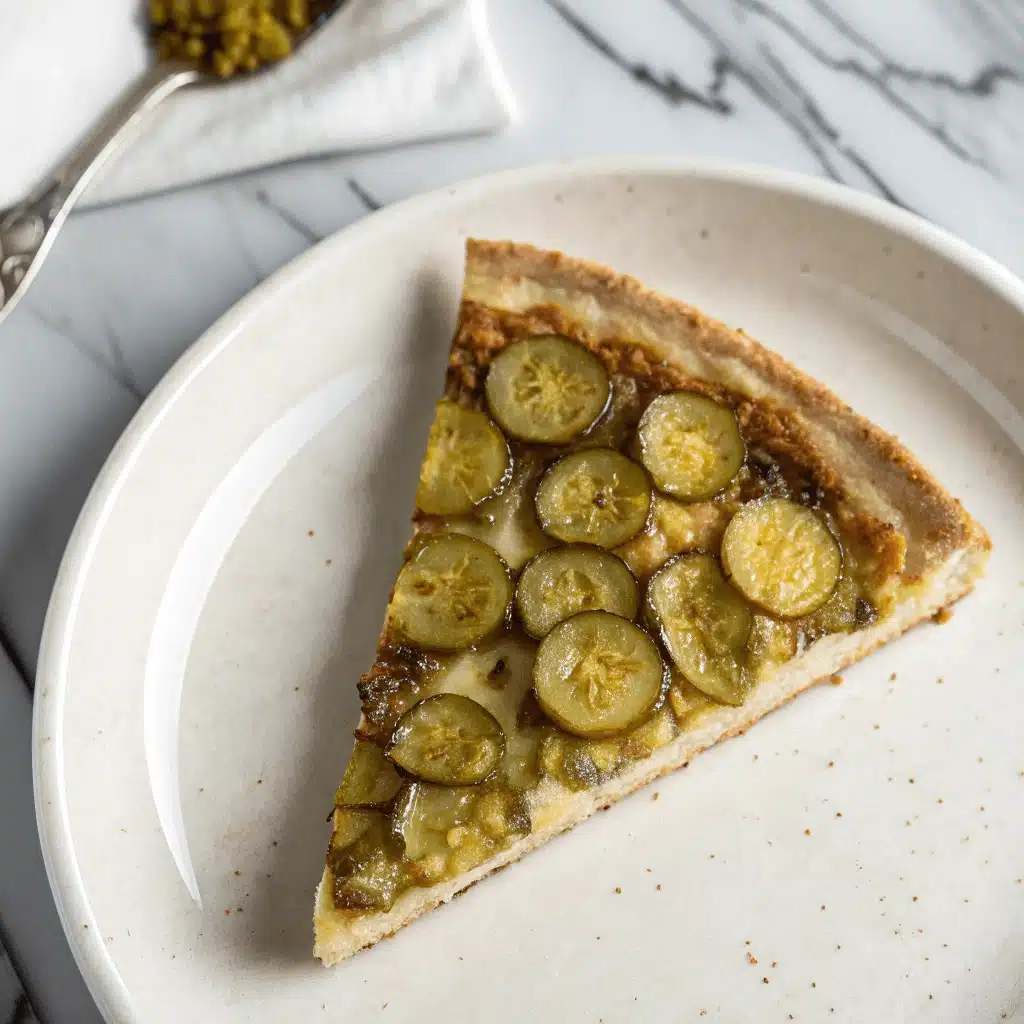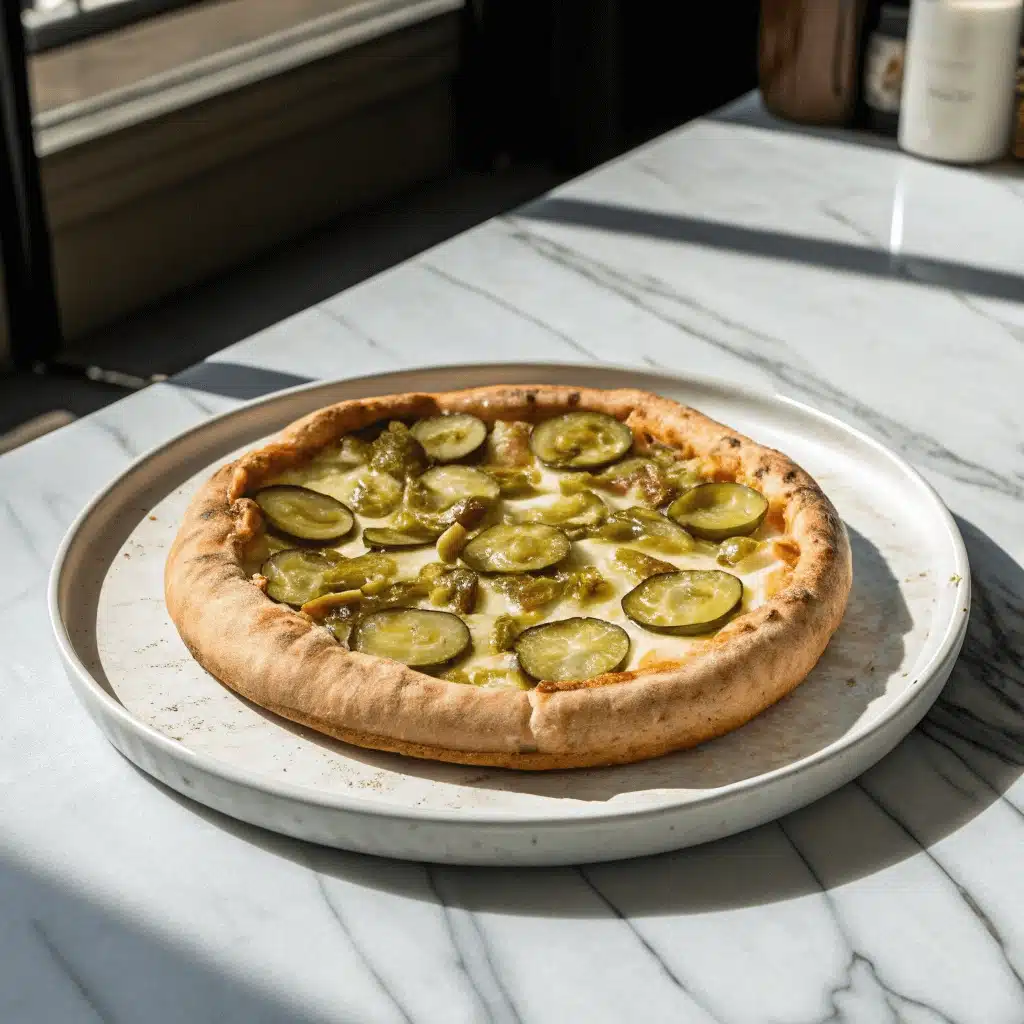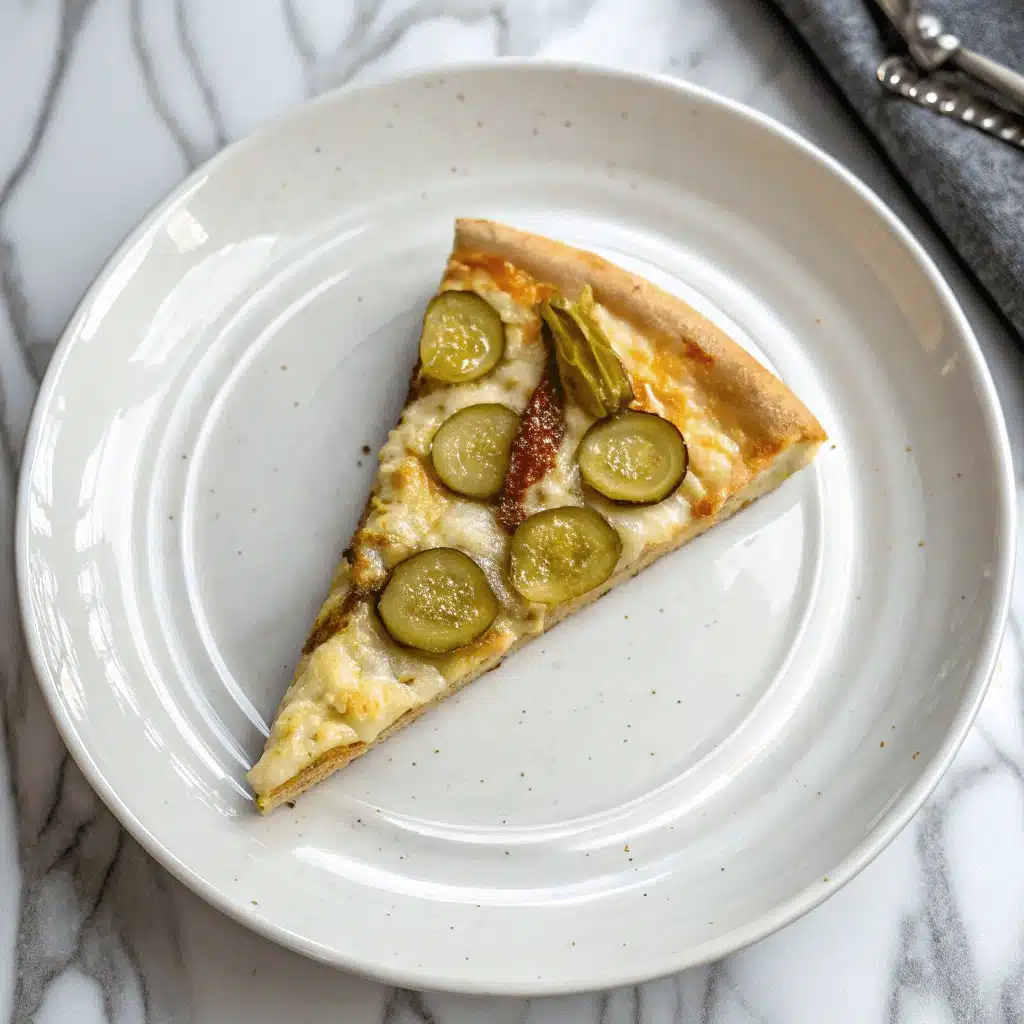Table of Contents
Table of Contents
Pickle Pie Pizza: 5 Amazing Reasons You’ll Love This Trend
You know that moment when you take a bite of something that sounds absolutely crazy but turns out to be downright amazing? That’s exactly what happened to me the first time I tried pickle pie pizza. Growing up in Madison, Georgia, my family and friends always gathered in our kitchen, sharing laughter and good food. My grandmother would always say, “Alice, the best recipes come from being brave enough to try something new.” Little did I know those words would lead me to discover one of the most surprisingly delicious pizza combinations I’ve ever tasted.
The first time I heard about pickle pie pizza, I’ll admit I was skeptical. I mean, pickles on pizza? It sounded like one of those viral food trends that’s more about shock value than actual taste. But after seeing the buzz around this unique creation, my curiosity got the better of me. After all, I’m someone who puts creative twists on classic recipes, so why not give this one a shot?
When I finally tried making my own pickle pie pizza at home, I was blown away by how perfectly the tangy pickles balanced with the creamy garlic sauce and melted cheese. The combination created this incredible flavor profile that was both familiar and exciting. It wasn’t just the taste that won me over either, it was how this simple pizza brought people together, sparking conversations and creating those memorable kitchen moments I’ve always cherished.
The Rise of Pickle Pie Pizza in Modern Cuisine
The story behind pickle pie pizza is fascinating and shows how modern food culture can turn the unexpected into something extraordinary. This unique pizza variation first gained attention when Rhino’s Pizzeria in Webster, New York, created their viral pickle pizza back in 2018. The creation spread like wildfire across social media platforms, dividing pizza lovers into passionate camps of supporters and skeptics.
From Viral Sensation to Kitchen Staple
What started as a bold experiment quickly became a legitimate food trend. PMQ Pizza Magazine even asked in their February 2023 issue: “Will 2023 Be the Year of the Pickle Pizza?” The publication noted that “pickle pizza went viral in 2018 and has steadily become a bigger and bigger favorite.”
Moreover, the trend gained serious credibility when it appeared on Netflix’s Chef’s Table: Pizza, featuring Ann Kim’s “Perfect Pickle Pie” from Young Joni in Minneapolis. The exposure transformed pickle pie pizza from internet curiosity to restaurant menu staple across the country.
The Minnesota State Fair played a significant role in popularizing this trend. Rick’s Pizza sold an incredible 50,000 slices of their pickle pizza during the 2022 fair. Their creation featured “a homemade hand-tossed pizza with specialty dill ranch sauce, mozzarella cheese, crunchy sliced dill pickles and topped with dill weed seasoning”.
Social Media’s Transformative Power
TikTok has been instrumental in spreading the pickle pie pizza phenomenon. The hashtag #PicklePizza has amassed over 16.4 million views on the platform. The visual appeal of this unusual pizza makes it perfect for social media sharing, with home cooks eagerly posting their own creations and reactions.
This digital word-of-mouth marketing has been incredibly effective because pickle pie pizza photographs beautifully. The contrast between the vibrant green pickles and golden cheese creates an eye-catching presentation that practically begs to be shared online.
You can find similar recipe inspiration in our buffalo chicken wrap and chicken pot pie casserole recipes, which also feature creative twists on beloved classics.
Print
Best Pickle Pie Pizza Recipe: 7 Viral Secrets Revealed
- Total Time: PT25M
- Yield: 8
- Diet: Vegetarian
Description
Tangy pickles, creamy cheese, and golden crust make this pickle pie pizza a bold, crave-worthy twist you’ll want to try again and again!
Ingredients
1 clove garlic, peeled and smashed
¾ cup sour cream
¼ cup mayonnaise
1–2 teaspoons water
½ teaspoon kosher salt
¼ teaspoon black pepper
1 teaspoon lemon juice
1 package (13 ounces) thin-crust pizza dough
2–3 dill pickles, thinly sliced
1 cup shredded mozzarella cheese
¼ cup parmesan cheese

Instructions
Step 1: Preheat oven to 400°F (200°C)
Step 2: In a medium mixing bowl, blend all the garlic sauce ingredients together until creamy and smooth
Step 3: Roll out pizza dough into a 12-inch round on parchment paper
Step 4: Spread garlic sauce evenly over dough, leaving ¾-inch border
Step 5: Layer sliced pickles over sauce, then sprinkle with mozzarella and parmesan cheese

Step 6: Bake for 16-20 minutes until cheese is bubbly and crust is golden brown
Step 7: Let rest 3 minutes before slicing and serving
Notes
Pat pickles dry to prevent soggy crust
Try different cheeses like gouda for extra flavor
For spicy kick, add jalapeños or hot sauce
Leftovers reheat well in toaster oven
- Prep Time: PT10M
- Cook Time: PT15M
- Category: Pizza
- Method: Baking
- Cuisine: American
What Makes Pickle Pie Pizza Different from Traditional Pizza
Pickle pie pizza stands apart from conventional pizzas in several key ways that create its distinctive appeal. While traditional pizzas rely on familiar flavor combinations like pepperoni and cheese or margherita toppings, pickle pie pizza introduces an entirely new taste experience that challenges our expectations.
The Perfect Blend of Tangy and Savory Flavors
The magic of pickle pie pizza lies in its ability to balance contrasting flavors harmoniously. The sharp, briny taste of dill pickles cuts through the richness of melted cheese, while a creamy garlic or ranch-based sauce serves as the perfect mediator between these bold elements.
According to food science, this combination works because pickles and dairy share complementary molecular compounds that make them naturally harmonious despite seeming like odd partners. The acidity in pickles brightens the overall flavor profile, preventing the pizza from becoming too heavy or one-dimensional.
Most pickle pie pizza recipes follow a basic formula: a white sauce base (typically garlic cream sauce or ranch), mozzarella cheese, and thinly sliced dill pickles. However, creative variations have emerged, with some cooks adding jalapeños for heat or different pickle varieties for unique flavor profiles.
Key Ingredients That Create the Magic
The success of pickle pie pizza depends on carefully selected ingredients that work together to create its signature taste. High-quality dill pickles are essential, with many recipes recommending jarred dill pickle slices that have been thoroughly dried to prevent sogginess.
The sauce typically consists of mayonnaise, sour cream, minced garlic, and seasonings, creating a rich base that complements rather than competes with the pickle flavor. Some versions incorporate ranch dressing or a simple garlic cream sauce made with butter, garlic, and milk.
The cheese component usually features low-moisture mozzarella to prevent the pizza from becoming soggy, often combined with Parmesan for additional flavor depth.
For more creative pizza inspiration, check out our amazing breakfast burrito recipe and marry me chicken pasta for other fusion dishes that combine unexpected flavors.

Step-by-Step Guide to Making Perfect Pickle Pie Pizza
Creating restaurant-quality pickle pie pizza at home requires attention to detail and proper technique. The key to success lies in managing moisture levels and layering flavors correctly to achieve that perfect balance of tangy, creamy, and savory elements.
Preparing the Dough and Sauce Foundation
Start by preheating your oven to 475°F (245°C) with a pizza stone or heavy baking sheet inside. This high heat is crucial for achieving a crispy crust that can support the toppings without becoming soggy.
For the sauce, combine ¾ cup sour cream, ¼ cup mayonnaise, 2-3 minced garlic cloves, 1 teaspoon dried dill, ½ teaspoon salt, and ¼ teaspoon black pepper in a bowl. Mix until smooth and let it rest for at least 15 minutes to allow flavors to meld.
The dough should be rolled or stretched to about 12-14 inches in diameter, maintaining an even thickness of approximately ¼ inch. Leave a slightly thicker border around the edges to create the crust.
Assembly and Baking Techniques
The most critical step is properly preparing the pickles. Pat dill pickle slices thoroughly dry with paper towels to remove excess moisture. This single step can make or break your pizza’s texture. Some recipes recommend pressing pickles between paper towels under a weighted cutting board for 10 minutes.
Spread the garlic sauce evenly over the dough, leaving a ¾-inch border for the crust. Add half the mozzarella cheese, then layer the dried pickle slices, and finish with the remaining cheese. This layering technique helps prevent the pickles from making the crust soggy.
Bake for 12-15 minutes until the crust is golden brown and the cheese is bubbly with light brown spots. Let the pizza rest for 3-5 minutes before slicing to allow the cheese to set slightly.
The finished pizza should have a crispy crust, melted cheese with golden spots, and pickles that maintain some of their original texture while being heated through.

Storage, Variations, and Pro Tips for Success
Understanding how to store, customize, and perfect your pickle pie pizza ensures you can enjoy this unique creation repeatedly while adapting it to different tastes and dietary needs.
Storage and Reheating Best Practices
Proper storage maintains the quality of leftover pickle pie pizza. Allow the pizza to cool completely before storing to prevent condensation. Place slices in an airtight container with parchment paper between layers if stacking. Refrigerate for up to 3-4 days.
For reheating, avoid the microwave which makes the crust soggy. Instead, use a 375°F oven for 8-10 minutes, an air fryer at 350°F for 3-4 minutes, or a covered skillet over medium-low heat for 5 minutes.
Creative Variations and Dietary Adaptations
The basic pickle pie pizza concept allows for numerous creative variations. For a spicier version, add pickled jalapeños or a drizzle of hot sauce. Some recipes incorporate bacon or ham for additional protein and smokiness.
For dietary restrictions, gluten-free crusts work well, though they may need par-baking to prevent sogginess. Vegan versions can use plant-based mayonnaise and cheese alternatives. The key is maintaining the essential pickle-forward character while accommodating different needs.
Seasonal variations might include adding caramelized onions in fall or fresh herbs in summer. The Minnesota State Fair has showcased numerous pickle-flavored foods, demonstrating the versatility of this flavor profile.
Professional Tips for Perfect Results
Several professional techniques can elevate your homemade pickle pie pizza. Cold-fermenting your dough for 24-72 hours develops better flavor and texture. Consider making your own quick pickles for ultimate control over flavor and moisture content.
Use a pizza steel rather than a stone if possible, as it transfers heat more efficiently. Position your oven rack in the upper third when using a home oven to ensure proper browning. Allow the garlic sauce to rest for at least 30 minutes before using to develop fuller flavor.
For additional comfort food inspiration, explore our smoked mac and cheese and funeral potatoes recipes that showcase similar creative approaches to classic dishes.

Frequently Asked Questions
What sauce do you use for pickle pizza?
The most popular sauce for pickle pizza is a creamy garlic sauce made with mayonnaise, sour cream, minced garlic, and seasonings. Some variations use ranch dressing or a simple garlic cream sauce, but avoid traditional tomato sauce as it competes with the pickle flavor.
How to make the state fair pickle pizza?
State fair pickle pizza typically features a thin crust with dill ranch sauce, mozzarella cheese, thinly sliced dill pickles, and dill weed seasoning. Rick’s Pizza at the Minnesota State Fair sold 50,000 slices using this combination. The key is thoroughly drying the pickles and using a hot oven for a crispy crust.
Is pickle pizza a thing?
Yes, pickle pizza has evolved from a viral internet trend to a legitimate menu item at pizzerias nationwide. It gained mainstream attention after appearing on Netflix’s Chef’s Table: Pizza and becoming a hit at state fairs. The combination of tangy pickles with creamy sauce and cheese creates a surprisingly delicious flavor profile.
What is pickle pie?
Pickle pie pizza is a specific style of pizza featuring dill pickles as the primary topping, typically served on a white sauce base with mozzarella cheese. The term “pickle pie” distinguishes it from other pickle-topped variations and emphasizes the pickle-forward flavor profile that defines this unique pizza style.
Conclusion
Pickle pie pizza perfectly captures the spirit of culinary adventure, showing that the most unexpected flavor combinations can become instant favorites. The tangy crunch of dill pickles, creamy garlic sauce, and melty cheese create a harmony that surprises and delights with every bite. As you experiment with variations whether adding spicy jalapeños, smoky bacon, or a gluten-free crust you’ll discover your own twist on this viral sensation. Embrace the fun of trying something new in your kitchen and share your creations with friends and family. Ready to give pickle pie pizza a try? Grab your ingredients, preheat the oven, and let this bold, playful recipe spark your next memorable meal.
Article updated 25 June 2025.
For more recipes, visit my Facebook page.
